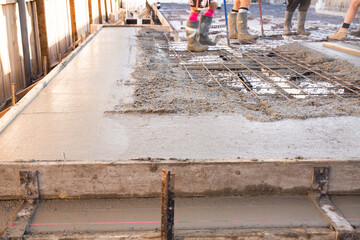Concrete is one of the most widely used construction materials, valued for its strength, versatility, and durability. From residential driveways and patios to commercial foundations and infrastructure projects, concrete is essential for creating long-lasting structures. However, achieving the best results requires expertise, proper techniques, and specialized knowledge. This is where concrete specialists play a crucial role. Their skills and experience ensure that every project is completed efficiently, safely, and with outstanding quality.

Why Hiring Concrete Specialists Matters
Concrete is more than just mixing cement, sand, and water. Professional concrete specialists understand the science behind the material, including the correct ratios, curing processes, and environmental considerations. Their expertise ensures:
- Structural Integrity: Properly mixed and poured concrete can withstand heavy loads and resist cracking over time.
- Aesthetic Appeal: Concrete specialists can create polished, stamped, or decorative finishes that enhance the visual appeal of surfaces.
- Efficiency: Experienced professionals complete projects faster while maintaining high-quality standards.
- Cost-Effectiveness: Proper installation reduces the likelihood of costly repairs or premature replacement.
Attempting DIY concrete projects or relying on inexperienced labor can result in uneven surfaces, weak foundations, or structural issues. Concrete specialists prevent these problems by combining technical knowledge with practical skills.
Services Provided by Concrete Specialists
Concrete specialists offer a wide range of services tailored to residential, commercial, and industrial projects:
- Concrete Installation: Experts manage the entire process, from site preparation and formwork to pouring, leveling, and finishing. Proper installation ensures durability and a smooth, attractive surface.
- Decorative Concrete: Concrete specialists can create stamped, stained, or polished surfaces that resemble natural stone, brick, or unique patterns. This service adds both functionality and visual appeal.
- Repair and Restoration: Cracks, chips, and worn-out concrete can compromise safety and appearance. Specialists assess the damage and use appropriate repair techniques to restore structural integrity.
- Driveway and Patio Solutions: Concrete specialists design and install driveways, patios, and walkways with attention to durability, drainage, and aesthetics.
- Commercial and Industrial Projects: From warehouse floors to large-scale foundations, concrete specialists ensure that heavy-duty projects meet performance and safety standards.
- Custom Projects: Concrete specialists can handle custom requests, including retaining walls, decorative slabs, steps, and unique landscape features.
Benefits of Working with Concrete Specialists
Hiring a concrete specialist offers several advantages over general contractors or DIY efforts:
- Expertise in Materials and Techniques: Specialists know which concrete mix suits specific projects, weather conditions, and load requirements.
- Precision and Accuracy: Skilled professionals ensure level surfaces, correct slopes for drainage, and uniform finishes.
- Advanced Equipment: Concrete specialists use professional tools and machinery, such as mixers, trowels, and vibrators, to achieve optimal results.
- Time Savings: Experienced teams complete projects efficiently, reducing delays and minimizing disruption to daily life or business operations.
- Long-Term Durability: Properly installed concrete withstands weather, wear, and heavy use for decades, providing excellent value.
Choosing the Right Concrete Specialist
Selecting a reliable concrete specialist is crucial for a successful project. Key factors to consider include:
- Experience and Expertise: Look for specialists with a proven track record in similar projects.
- Portfolio of Work: Reviewing completed projects demonstrates skill, style, and attention to detail.
- Professional Certifications: Certifications and industry memberships indicate a commitment to quality standards and best practices.
- Transparent Pricing: Clear estimates and explanations of costs prevent unexpected expenses.
- Customer Reviews: Positive feedback from previous clients highlights reliability, professionalism, and quality.
Tips for Maintaining Concrete Surfaces
Even the best concrete requires proper care to maximize longevity and appearance. Concrete specialists often recommend:
- Sealing: Applying a sealant protects surfaces from moisture, stains, and wear.
- Regular Cleaning: Sweep and wash surfaces to prevent dirt, debris, and mold buildup.
- Prompt Repairs: Address minor cracks or chips quickly to prevent further damage.
- Avoid Harsh Chemicals: Use cleaners specifically designed for concrete to avoid surface deterioration.
- Proper Drainage: Ensure water flows away from surfaces to prevent pooling and erosion.
Innovations in Concrete Solutions
Concrete specialists stay up-to-date with the latest industry innovations to provide superior results. Modern techniques include:
- Self-Leveling Concrete: Ideal for floors and surfaces that require a smooth, even finish with minimal manual effort.
- High-Strength Concrete: Designed for heavy-duty projects, it provides enhanced durability and resistance to environmental stress.
- Eco-Friendly Concrete: Incorporates recycled materials, reduces carbon footprint, and promotes sustainability.
- Decorative Finishes: New stamping, staining, and polishing techniques create unique patterns and textures that enhance aesthetic appeal.
Concrete specialists play a vital role in ensuring the success of any concrete project. Their expertise, equipment, and knowledge guarantee durable, visually appealing, and functional surfaces for residential, commercial, and industrial applications. From installation and repair to decorative finishes and large-scale construction, concrete specialists deliver results that last.
Investing in professional concrete services protects your property, enhances its value, and saves time and money over the long term. By choosing skilled specialists and following proper maintenance practices, property owners can enjoy safe, strong, and beautiful concrete surfaces that stand the test of time.
Whether constructing a new driveway, renovating a patio, or completing a commercial foundation, working with concrete specialists ensures that every project meets the highest standards of quality, durability, and craftsmanship.